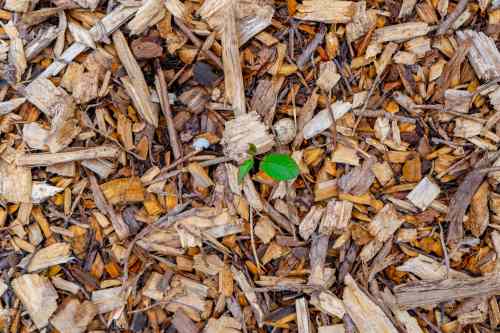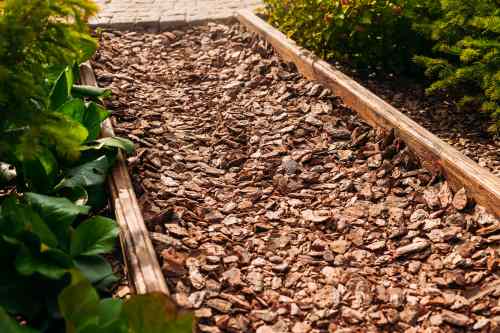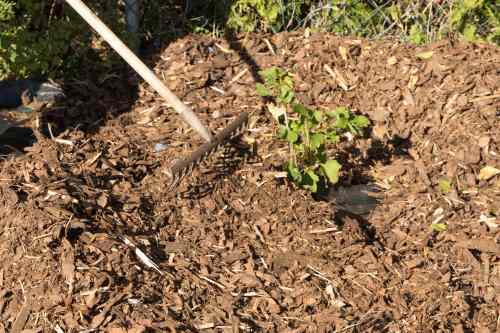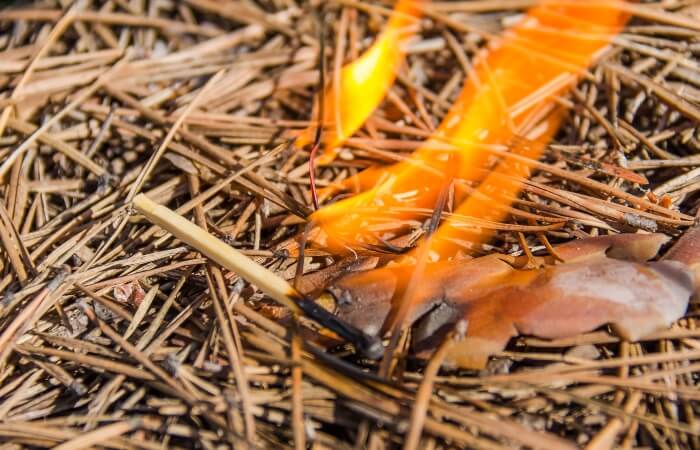Homeowners often wonder if it’s okay to use wood chips in the garden.
The answer is yes! There are many uses for wood chips for your gardening projects.

Wood chips from a freshly-felled tree or older wood chips from a municipal yard-waste collection center are low-cost, useful gardening materials when you use it properly.
In this guide, I list 5 uses to repurpose wood chips, with pros, cons, and some useful tips.
So, if you have access to a pile of wood chips, stick around to learn the best ways to incorporate them into your garden!
5 Ways to Use Wood Chips in the Garden
1. Wood Chip Mulch

The most obvious way to use wood chips is for mulch around plants in your garden and landscape. The wood chips naturally decompose and in the process, improves the soil texture.
Benefits
The benefits of using wood chip mulch start with how it helps regulate soil temperature (warmer in winter, cooler in summer), which aids in keeping plant roots healthy.
SEE ALSO: Fertilizer vs Compost to help keep your plants healthy.
Wood chips also shade the soil and absorb water to keep moisture levels more consistent, so plants need less watering.
Another benefit is how weeds find it challenging to grow in wood chip mulch, which is a pleasant surprise to many gardeners!
Weed suppression is a good reason to spread wood chips in areas you want to spend less time managing, like around dense shrubbery.
Disadvantages
Using wood chip mulch causes a nitrogen deficiency at the top of the soil where it touches the chips.
Disease-prone plants, including roses and tomatoes, are easily overcome by fungal spores that like to hide and grow inside wood chip mulch.
TIPS: Use a three-inch layer of wood chips for optimal effectiveness. Learn more about wood chip mulch and possible adverse effects on surrounding plants.
Always keep wood chips a few inches away from the base of plants to deter disease growth and allow the stem or trunk to breathe.
2. Wood Chip Walkways
Walkways made from a deep layer of wood chips are a fantastic way to repurpose a large quantity of material from trees you remove from your property and send through the chipper.

Place wood chips in rows between mounded or raised planter beds. The chips form a barrier between the ground and your shoes while you work in your garden.
The wood chips are a huge benefit for keeping your boots mud-free, especially after rains or watering.
Another benefit of wood chip walkways is how they can create a weed-free, natural-looking pathway to connect different areas of your landscaping. You can easily lay the wood chips to form curves and even out surfaces that would be difficult to accomplish using paver stones.
The biggest con of wood chip walkways is that you need to keep topping them off each year as they decompose. Another caution is the risk of splinters from fresh wood chips when wearing open-weave shoes while walking over the material.
TIP: Five or six inches of wood chips is ideal for creating walkways. At this depth, the wood chips will compress into a firm layer that retards weed growth, yet retains enough “give” to make it comfortable to stand on for extended periods.
3. Add Wood Chips To Your Compost Pile
If you love to compost like me, wood chips can be a welcome addition to your pile or bin.
You may need to tackle a large collection of wood chips in small increments. This technique will make it simple to keep your compost pile in balance.
The pros of wood chip composting are that it adds an impressive amount of carbon to your pile, which is excellent for creating a rich compost medium.
Wood chips work as a “brown” ingredient, that will break down and add nutrients when the compost is complete.
Taking those annoying piles of branches that accumulate from pruning your trees and turning them into wood chips benefits your compost bin and tidies up your yard.
The con to adding wood chips to your compost pile is that it temporarily slows down the composting process since the material is tougher to break down.
The finer the wood chips, the faster they will decompose, but make sure you balance in plenty of “green” ingredients to keep the compost pile healthy.
TIP: If you have a small pile of wood chips you don’t care to add to your compost bin, they will degrade aerobically all on their own. You won’t even need to turn the pile if you can keep the moisture level consistent.
4. Wood Chips To Prevent Soil Erosion
Wood chips form an effective temporary barrier in areas of your garden or lawn that are eroding from rains or wind.
Erosion control keeps your garden and landscaping plants healthier, while also reducing mucky run-off from your property into the streets or your neighbor’s lawn.
The pro of using wood chips for erosion control is the ability to till them into the soil to build up low areas. The wood will absorb water and help hold the ground until you form a permanent solution.
A very thick layer will compress after a short period yet allow excess water to drain through.
Once you develop a permanent plan to fix problem areas, you can easily rake up the wood chips to add to your compost pile. You can also repurpose it as garden mulch.
The only con is that a dense layer of wood chips could kill off grass in the areas you are trying to control.
TIP: For optimal erosion control, try to keep the wood chips moist. Damp chips have less tendency to blow away during high winds.
5. Wood Chips To Control Invasive Plant Growth

Does your property border woods or other natural areas?
Wood chips not only form an attractive border to delineate your property lines but can keep wild plants from encroaching into your lawn.
If you have a wood-chip pile from trees that came down in your yard, using them up as a weed-control border is free and eliminates that ugly pile.
The benefit of using wood chips in this way is the ability to use up large quantities since you’ll need a very deep layer to kill off roots and plant growth.
TIP: For the best plant growth deterrent, create a wood chip barrier three to four feet wide by two-foot deep. This amount will smother roots before they can grow onto your property.
The best way to maintain your border-control wood chip barrier is to add a fresh six-inch layer each year, to offset the material that decomposes underneath.
Use a chipper as you prune your shrubs and trees, and use the content to refresh the border. This method keeps your whole yard looking neat.
Related | How Much To Rent A Wood Chipper?
In Summary
When you have an abundance of wood chips and no idea how to use them, put them to good use in your garden!
I hope this article encourages you to turn wood chips into garden mulch, attractive pathways, compost ingredients, and help with erosion and weed control.
Now that you know the best uses for wood chips and how to use them correctly, you can use this budget-friendly solution to solve problems and beautify your landscape!










